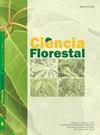2006年至2012年巴西联邦保护区森林火灾的原因和发生时间
IF 0.5
4区 农林科学
Q4 FORESTRY
引用次数: 0
摘要
森林火灾,无论其原因如何,都是对巴西保护区生物多样性的最大威胁之一。收集有关火灾发生的原因、时期和地点的数据,有助于采取更有效的预防策略。本研究的目的是描述2006年至2012年巴西联邦保护区的森林火灾特征,从而有助于提高对这些地区火灾动态的认识。数据来自国家火灾信息系统(SISFOGO,葡萄牙语)数据库中的火灾发生记录(ROIs,葡萄牙语)。发现的记录总数为2259份,其中88.2%报告了原因。在报告原因的记录中,42.2%对应于未知原因,26.7%对应于碎片燃烧,18.5%对应于纵火事件,这表明大多数已知原因的火灾是意外或故意人为行为的结果。受年降水量分布的影响,7 - 10月森林火灾多发,平均每年50.6次。米纳斯吉拉斯州、巴西里约热内卢州和塞埃尔本文章由计算机程序翻译,如有差异,请以英文原文为准。
Causes and period of occurrence of forest fires in Brazilian federal protected areas from 2006 to 2012
Forest fires, regardless of their causes, represent one of the greatest threats to biodiversity in Brazilian protected areas. Collecting data on the causes, periods, and sites with the highest occurrence of fires allows for the adoption of more effective prevention strategies. The aim of this study was to characterize forest fires in Brazilian federal protected areas from 2006 to 2012, thus contributing to improving the knowledge of the dynamics of fires in these areas. Data were obtained from Fire Occurrence Records (ROIs, in Portuguese) available in the National Fire Information System (SISFOGO, in Portuguese) database. The total number of records found was 2,259, of which 88.2% had reported causes. Among the records with a reported cause, 42.2% correspond to unknown causes, 26.7% to debris burning, and 18.5% to arson events, which shows that the majority of fires with a known cause are the result of accidental or intentional human action. Forest fires were more frequent from July to October, with a mean of 50.6 occurrences per year, influenced by the annual precipitation distribution. Minas Gerais, Rio de Janeiro and Ceará were the states with the highest number of records, with 19.8%, 15.5%, and 12.0%, respectively. Forest fires reported without any cause information or reported as unknown cause indicate, respectively, a poor use of the tool (ROI) or an unsatisfactory expertise in identifying the cause of the fire, resulting in an obstacle for planning actions to prevent and fight forest fires in protected areas.
求助全文
通过发布文献求助,成功后即可免费获取论文全文。
去求助
来源期刊

Ciencia Florestal
农林科学-林学
CiteScore
0.80
自引率
0.00%
发文量
85
审稿时长
18-36 weeks
期刊介绍:
The journal Forest Science was established in 1991 with the goal of being a vehicle for dissemination which are published works tércnico-scientific forest-related, the following bodies crowded the Centro de Ciências Rurais of Universidade Federal de Santa Maria:
- Centro de Pesquisas Florestais - CEPEF
- Programa de Pós-graduação em Engenharia Florestal - PPGEF
- Departamento de Ciências Florestais - DCFL
MISSION:
Publish scientific papers, technical notes, and literature reviews related to the area of forest sciences.
 求助内容:
求助内容: 应助结果提醒方式:
应助结果提醒方式:


